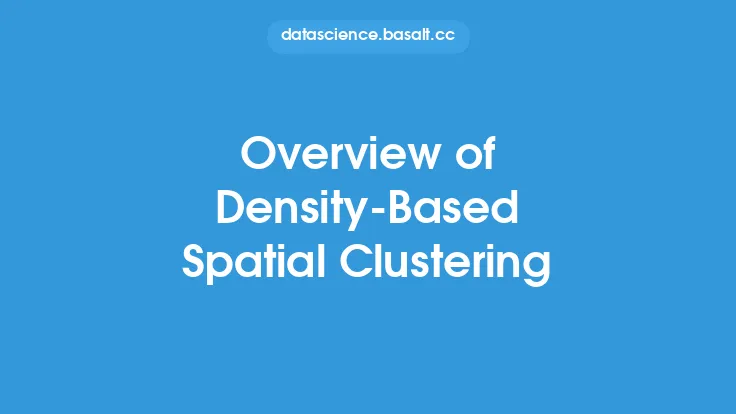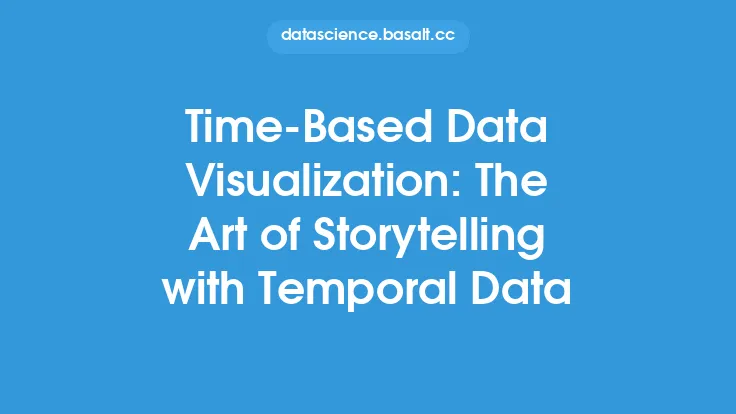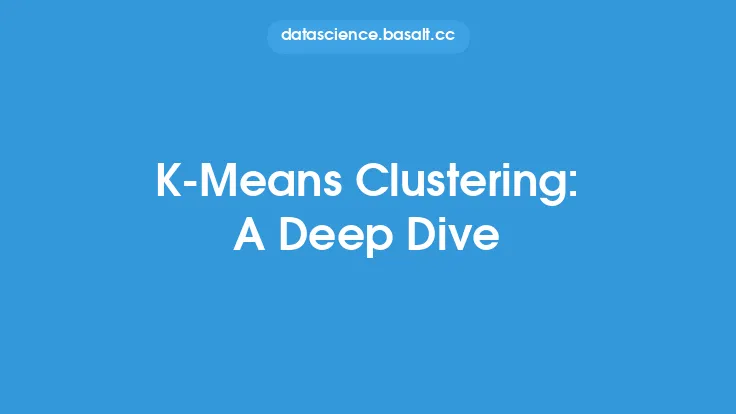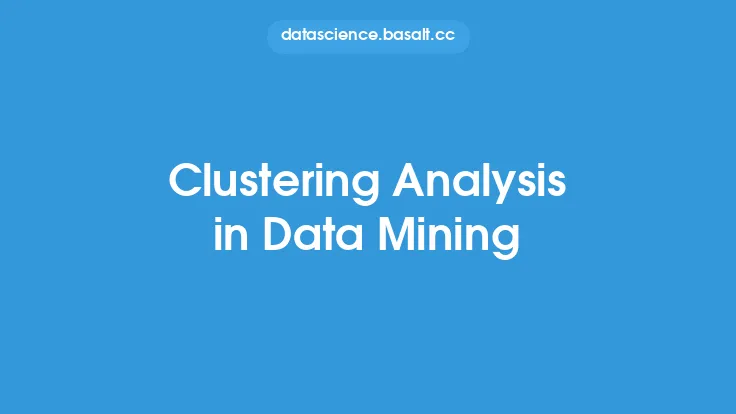DBSCAN is a popular unsupervised learning algorithm used for clustering data points based on their density and proximity to each other. It is widely used in various fields, including data mining, machine learning, and spatial analysis. The algorithm is particularly useful for identifying clusters of varying densities and shapes, as well as for detecting noise and outliers in the data.
Introduction to DBSCAN
DBSCAN is an acronym that stands for Density-Based Spatial Clustering of Applications with Noise. It was first introduced in 1996 by Martin Ester, Hans-Peter Kriegel, Jörg Sander, and Xiaowei Xu. The algorithm is based on the idea that clusters are dense regions of data points that are separated by sparse regions. DBSCAN uses two key parameters, epsilon (ε) and minPts, to determine the density of the data points and to identify clusters.
Key Parameters of DBSCAN
The two key parameters of DBSCAN are epsilon (ε) and minPts. Epsilon (ε) is the maximum distance between two data points in a cluster, and minPts is the minimum number of data points required to form a dense region. The value of epsilon (ε) determines the maximum radius of the neighborhood around each data point, while the value of minPts determines the minimum number of data points required to form a cluster.
How DBSCAN Works
DBSCAN works by iterating through each data point in the dataset and determining whether it is a core point, a border point, or a noise point. A core point is a data point that has at least minPts data points within a distance of epsilon (ε). A border point is a data point that is within a distance of epsilon (ε) from a core point, but does not have enough data points within a distance of epsilon (ε) to be considered a core point. A noise point is a data point that is not a core point or a border point.
Types of Data Points in DBSCAN
There are three types of data points in DBSCAN: core points, border points, and noise points. Core points are the data points that are at the center of the clusters, and they have a high density of data points around them. Border points are the data points that are at the edge of the clusters, and they have a lower density of data points around them. Noise points are the data points that do not belong to any cluster, and they are typically outliers or anomalies in the data.
Advantages of DBSCAN
DBSCAN has several advantages over other clustering algorithms. It can handle clusters of varying densities and shapes, and it can detect noise and outliers in the data. DBSCAN is also robust to the choice of parameters, and it can handle high-dimensional data. Additionally, DBSCAN is a non-parametric algorithm, which means that it does not require a fixed number of clusters to be specified beforehand.
Disadvantages of DBSCAN
Despite its advantages, DBSCAN has several disadvantages. It can be sensitive to the choice of epsilon (ε) and minPts, and it can be computationally expensive for large datasets. DBSCAN also assumes that the data points are uniformly distributed, which may not always be the case. Additionally, DBSCAN can be difficult to interpret, especially for high-dimensional data.
Applications of DBSCAN
DBSCAN has a wide range of applications in various fields, including data mining, machine learning, and spatial analysis. It is commonly used for clustering customer data, detecting anomalies in network traffic, and identifying patterns in spatial data. DBSCAN is also used in image segmentation, gene expression analysis, and recommender systems.
Real-World Examples of DBSCAN
DBSCAN has been used in several real-world applications, including clustering customer data for a retail company, detecting anomalies in network traffic for a cybersecurity firm, and identifying patterns in spatial data for an urban planning project. For example, a retail company used DBSCAN to cluster customer data based on their purchasing behavior, and they were able to identify several distinct customer segments. A cybersecurity firm used DBSCAN to detect anomalies in network traffic, and they were able to identify several potential security threats.
Comparison with Other Clustering Algorithms
DBSCAN is often compared with other clustering algorithms, such as K-Means and Hierarchical Clustering. DBSCAN is more robust to noise and outliers than K-Means, and it can handle clusters of varying densities and shapes. DBSCAN is also more flexible than Hierarchical Clustering, and it can handle high-dimensional data. However, DBSCAN can be computationally expensive, and it can be sensitive to the choice of parameters.
Future Directions of DBSCAN
DBSCAN is a widely used clustering algorithm, and it has several future directions. One of the future directions of DBSCAN is to develop more efficient algorithms for large datasets. Another future direction is to develop more robust algorithms that can handle high-dimensional data and non-uniform distributions. Additionally, there is a need to develop more interpretable algorithms that can provide insights into the clusters and the data.
Conclusion
DBSCAN is a popular unsupervised learning algorithm used for clustering data points based on their density and proximity to each other. It is widely used in various fields, including data mining, machine learning, and spatial analysis. DBSCAN has several advantages, including its ability to handle clusters of varying densities and shapes, and its robustness to noise and outliers. However, it also has several disadvantages, including its sensitivity to the choice of parameters and its computational expense. Despite its limitations, DBSCAN is a powerful algorithm that can provide valuable insights into the data, and it has a wide range of applications in various fields.





